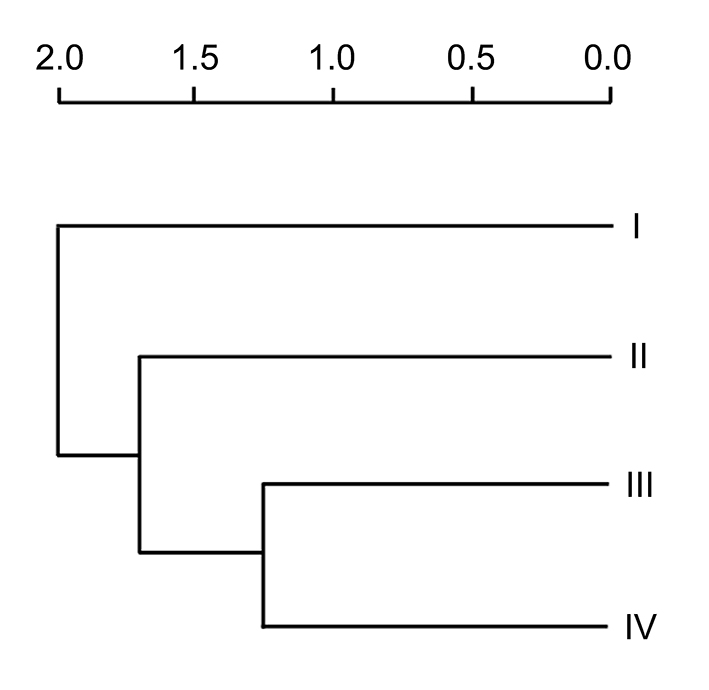对250份国外甜瓜(Cucumis melo)种质资源的19个形态性状多样性进行研究。结果表明, 国外甜瓜种质资源具有丰富的形态多样性, 平均遗传多样性指数为1.378。9个质量性状(果实形状、果皮底色、覆纹颜色、覆纹形状、网纹密度、网纹粗度、果肉颜色、果肉质地和种子颜色)和4个数量性状(单果鲜重、果肉厚度、可溶性固形物含量和种子千粒重)变异明显, 其Shannon’s指数分别大于1.0和1.9。不同生态区间种质资源遗传多样性差异明显, 多样性指数由高到低依次为: 南亚(1.512)、东北欧(1.404)、西欧(1.372)、北美(1.340)和东亚(1.281)。通过聚类分析将所有甜瓜种质划分为四大组群, 即南亚组群、东北欧组群、西欧北美组群和东亚北美组群。以印度为代表的南亚甜瓜种质形态多样性水平较高, 支持了印度次生大陆为甜瓜起源中心的观点。
We studied the morphological diversity of 250 foreign melon germplasm by examining 19 morphological characters. The foreign melon germplasm was rich in morphological diversity, with mean diversity index (Shannon’s index, H′) of 1.378. We found great variety in 9 qualitative characters (fruit shape, ground color of fruit skin, vein color of fruit skin, vein shape of fruit skin, density of net, thickness of net, flesh color, flesh texture, and seed coat color) and 4 quantitative characters (fresh weight of single fruit, thickness of fruit flesh, soluble solid content, and 1 000-seed weight), with H′ greater than 1.0 and 1.9, respectively. The degree of genetic diversity between various regions differed greatly. The upper-to-lower order of H′ for the various regions was south Asia (H′=1.512), northeast Europe (H′=1.404), west Europe (H′=1.372), north America (H′=1.340), and east Asia (H′=1.281). Cluster analysis divided the melon germplasm into four groups; south Asia, northeastern Europe, west Europe-North America, and east Asia-North America. The melon germplasm in south Asia (mainly represented by India) were rich in morphological diversity, which supports the Indian subcontinent as the original center of melon.

胡建斌, 马肖静, 李琼. (2010). 薄皮甜瓜表型性状的主成分分析. 江西农业学报 22: 30-33.
林德佩 (1989). 甜瓜植物(Cucumis melo L.)分类系统的研究. 中国西瓜甜瓜 (1): 11-16.
林德佩 (2010). 中国栽培甜瓜植物的起源、分类及进化. 中国瓜菜 23: 34-36.
马双武, 刘君濮 (2006). 甜瓜种质资源描述规范和数据标准. 北京:中国农业出版社. pp. 15–33.
张鲁刚, 王鸣 (1990). 甜瓜种质资源的Q型聚类分析及主成分分析. 中国西瓜甜瓜 (1), 14-19.
张永兵, 李寐华, 吴海波, 伊鸿平, 吴明珠. (2012). 新疆甜瓜地方品种资源的表型遗传多样性. 园艺学报 39: 305-314.
中国农业科学院郑州果树研究所 (2000). 中国西瓜甜瓜. 北京: 中国农业出版社. pp. 12–18.
Fergany M, Kaur B, Monforte AJ, Pitrat M, Rys C, Lecoq H, Dhillon NPS, Dhaliwal SS (2011). Variation in melon (Cucumis melo) landraces adapted to the humid tropics of southern India. Genet Resour Crop Evol 58: 225-243.
Kerje T, Grum M (2000). The origin of melon, Cucumis melo: a review of the literature. ISHS Acta Hort 510: 37-44.
Kirkbride JH (1993). Biosystematic monograph of the genus Cucumis (Cucurbitaceae). North Carolina: Parkway Publishers. pp. 84–88.
Liu L, Kakihara F, Kato M (2004). Characterization of six varieties of Cucumis melo L. based on morphological and physiological characters, including shelf-life of fruit. Euphytica 135: 305-313.
Munger HM, Robinson RW (1991). Nomenclature of Cucumis melo L. Cucurbit Genet Coop Reports 14, 43-44.
Pitrat M, Hanelt P, Hammer K (2000). Some comments on intraspecific classification of cultivars of melon. ISHS Acta Hortic 510: 29-36.
Robinson RW, Decker-Walters DS (1997). Cucurbits. New York: CAB International. pp. 64–66.
Roy A,Bal SS,Fergany M,Kaur S,Singh H,Malik AA,Singh J,Monforte AJ,Dhillon NPS (2012). Wild melon diversity in India (Punjab State). Genet Resour Crop Evol 59: 755-767.
Stepansky A, Kovalski I, Perl-Treves R(1999). Intraspecific classification of melons (Cucumis melo L.) in view of their phenotypic and molecular variation. Plant Syst Evol 217, 313-332.
Szamosi C, Solmaz I, Sari N, Bársony C (2010). Morphological evaluation and comparison of Hungarian and Turkish melon (Cucumis melo L.) germplasm. Sci Hortic 124: 170-182.
Tanaka K, Nishitani A, Akashi Y, Sakata Y, Nishida H, Yoshino H, Kato K. (2007). Molecular characterization of South and East Asian melon, Cucumis melo L., and the origin of Group Conomon var. makuwa and var. conomon revealed by RAPD analysis. Euphytica 153: 233-247.
Yashiro K, Iwata H, Akashi Y, Tomita K, Kuzuya M, Tsumura Y, Kato K (2005). Genetic Relationship among East and South Asian Melon (Cucumis melo L.) Revealed by AFLP Analysis. Breed Sci 55: 197-206.



